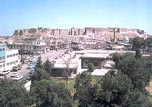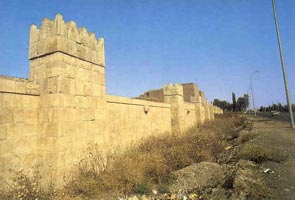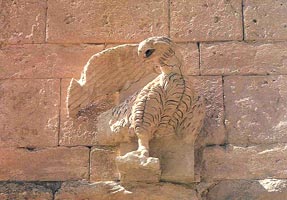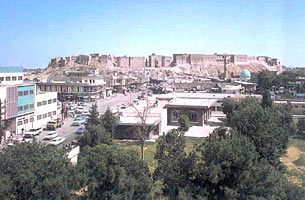 New Page 1
New Page 1
|
Tour in the North
Historical Sites
MOUSUL:
-
MASHAD YAHYA ABUL KASSEM:
On the right bank of Tigris, known for its
conical dome, decorative brick work and calligraphy engraved in Mosul
blue marble, 13th century.
-
QARA SARAI (The black palace):

The remnants of the 13th century
palace of Sultan Badruddin Lu’lu’.
-
BASH TEPA CASTLE:
Part of Mosul’s old walls
which have disappeared,
with the exception of these imposing ruins rising high over Tigris.
-
NINEVEH:
The city Nineveh had a glorious history, which made the
Governorate assume its name. It was the third Assyrian capital after Assur and Nimrud, and its position in the center of the original
Assyrian lands between the rivers Tigris and Zab gave it an added
administrative and religious importance. But it had been a cultural
settlement since long before, right through Sumerian and Babylonian
periods. In fact the name of Nineveh is of Sumerian origin.
 Nineveh was ruled by a number of great Assyrian kings, such as Sargon ii
(721-705 B.C), before he moved to Dur Sharrukin (Khorsabad), succeeded
by his son Sennacherib (705-681 B.C) who abandoned his father’s new
capital and went back to Nineveh, and Esarhaddon (608-699 B.C) AND
Assur-bani-pal (619-626 B.C), all of whom enlarged and built up the city
and made it the center of the civilized world of their time. Sennacherib
brought water to it in an 80 km long canal from river Gomel, built a dam
for water regulation the remains of which are still visible somewhere
near the eastern wall, and filled the city and its environs with gardens
and orchards to which he brought some rare trees. Nineveh was ruled by a number of great Assyrian kings, such as Sargon ii
(721-705 B.C), before he moved to Dur Sharrukin (Khorsabad), succeeded
by his son Sennacherib (705-681 B.C) who abandoned his father’s new
capital and went back to Nineveh, and Esarhaddon (608-699 B.C) AND
Assur-bani-pal (619-626 B.C), all of whom enlarged and built up the city
and made it the center of the civilized world of their time. Sennacherib
brought water to it in an 80 km long canal from river Gomel, built a dam
for water regulation the remains of which are still visible somewhere
near the eastern wall, and filled the city and its environs with gardens
and orchards to which he brought some rare trees.
On rising ground you can see the remains of the ancient walls, partly
reconstructed, 12 kms in circumference. There were 15 gates each called
after an Assyrian god. The two most prominent mounds of ruins are
Koyunjuk and Nabi Younis (Jonah). King Esarhadon had once built a palace
on this very hill.
On Koyunjuk hill are the remains of the most important palaces of the
period: Sennacherib’s palace, with 71 chambers and halls and 27
entrances, embellished with winged bulls and lions. The walls had lond
series of bas-reliefs most of which were taken to the British museum, as
they were dug up by quite unscientifically by European excavators in the
middle of the 19th century, when Iraq was still under Ottoman
domination. Assurbanipal left us some even more magnificent bas-reliefs
and library with thousands of clay tablets which he colleted from
various cities and which preserved for us much of the lore and knowledge
of ancient Mesopotamia.
-
NIMRUD:
The second capital of Assyria had been a well-settled place
for a thousand years before it was built as a center of his kingdom by Shalmaneser I (1273 – 1244 B.C). A famous king of Nimrud was
Assur-nasir-pal II (883-859 B.C), and so was his son Shalmaneser III
(858-824) who constructed its ziggurat together with a temple next to
it.
Lying as it does on the east bank of the Tigris, 37 kms to the south
east of Mosul, the city has a four side wall measuring in all 8 kms, and
several buildings, in the south western and south eastern corners,
raised on mud brick platforms as much as forty feet high above river
level.
-
DUR SHARRUKIN (KHORSABAD):
The fourth capital of Assyria, built by
Sargon II (721-705 B.C) on a square plan with a mud brick wall with 7
gates. The inside walls of the king’s palace were covered with
magnificent marble (and some bronze) bas-reliefs, which were taken by
the archaeologists to the Louvre in the 19th century. The massive winged
bulls, which guarded the doorways, were scattered over a number of
museums in the world. Two of them are in the Iraqi museum in Baghdad.
The palace is in need of much excavation and reconstruction, which, it
is hoped, are in the offing. Ironically, this city was not lived in for
long: Sargon was killed only one year after he moved into it, and his
son Sennacherib went back to Nineveh and carried away with him many of
its sculptures to decorate his palace there.
-
ASSUR:
The first capital of a people who named their city after
their major god, and who in time built a vast empire which included
Iraq, Syria, Anatolia, Iran, Egypt and parts of Arabia.
Assur (today called qalat Shergat) is 11 kms to the south of Mosul, near
Himrin Mountains believed by Assyrians to be the abode of god
Assur. It
lies on a stony hill overlooking the Tigris on the east. To the north of
it is the river’s old course. An inner wall and an outside wall, with
several gateways, fortified it.
It had been a human settlement long before it became a capital, and it
was known to have come under the dominion of Akkad, of the third Dynasty
of Ur, and of the Babylonians in the 31st year of Hammurabi’s reign.
Assur continued to be the Assyrian capital until Ashurnasirpal (883-859
B.C) removed the seat of power to Nimrud (Kalakh), where his son
Shalmaneser III reigned after him. But Assur maintained its religious
distinction. Its most striking sights today is the ziggurat, devoted to
the god Assur, as well as the ground temple nearby devoted to the same
god and called Temple of the Universe. There are also temples devoted to
the gods of the sun and the moon, and one with towers sacred to Anu, god
of the sky, and Adad, god of storms.
The city overflowed its walls, and many buildings were erected beyond
them, notably the Akitu temple where the New Year Festivals were
celebrated. It was built by Sennacherib on the river bank (now the old
course of the Tigris) and had it surrounded by extensive gardens.
-
HATRA:
The ancient Arab city of Hatra, near Wadi Tharthar, is 27
kms. To the west of the Baghdad-Mosul highway, at a point 80 kms south
of Mosul. In architecture, sculpture, metal work, the arts of war. Hatra
was no less advanced than Rome. It was another link in the chain of
great Arab cities: Palmyra in Syria, Petra in Jordan and Baal beck in
Lebanon, and others.
 Although Iraq possess a few texts that may tell us about the obscure
beginning of the city, it seems it began actually to grow sometime in
the third century B.C. Before the foundations of kingship around A.D.
156, Hatra was governed by Arab rulers who was Nasr, father of the first
two kings of Hatra: Lajash and Sanatruq. The latter was succeeded by
Sanatruq II (A.D. 200-241), the last Arab king of the city. When the
city comes into view you will see an earthen barrier that goes round it
with a diameter of about 3 kms, and about 500 meters away from it you
will see a great stone wall with tower bastions and four gateways (at
the four points of the compass), noted for their oblique entrance, like
the gateways of Mansour’s round City of Baghdad. Although Iraq possess a few texts that may tell us about the obscure
beginning of the city, it seems it began actually to grow sometime in
the third century B.C. Before the foundations of kingship around A.D.
156, Hatra was governed by Arab rulers who was Nasr, father of the first
two kings of Hatra: Lajash and Sanatruq. The latter was succeeded by
Sanatruq II (A.D. 200-241), the last Arab king of the city. When the
city comes into view you will see an earthen barrier that goes round it
with a diameter of about 3 kms, and about 500 meters away from it you
will see a great stone wall with tower bastions and four gateways (at
the four points of the compass), noted for their oblique entrance, like
the gateways of Mansour’s round City of Baghdad.
Going round the city you will see a large edifice in front of the
recently discovered gateway and the eastern gateway, which is just off
the street.
The inscriptions in Hatra are the same alphabets used by Arabs in
Palmyra and other Arab cities: it is the Aramaic that spread in most
regions of the ancient East. Some inscriptions read as follows.” Kings
and princes of Hatra are the victorious kings of the Arabs.”
Near the remains of the ancient city there is a modern rest house.
DUHOK:
ARBIL:
-
ARBIL FORTRESS:

The most prominent historical site, which is seen
from all over Arbil. Arab historians mentioned its fortress, which has
been reconstructed by the General establishment of Antiquities and
Heritage. It rises upon a great mound, which hides several layers of
ancient pre-Islamic settlements.
SALAHUDIN:
-
SAMARRA CALIPH’S RESIDENCE: Built by Al-Mu’tasim to overlook the
Tigris with a front 700 meters long. What remains of it today is a group
of three “ewans” giving onto the river, the central one measuring 17.5 x
8 meters, with a height of 12 meters. These “ewans” were called “The
commoners gate”; the Caliph would sit there to hear the people’s
complaints and suggestions, as Arab Caliphs always took personal
interest in their citizens’ affairs.
-
MA’SHOUQ PALACE: About 10 kms to the northwest of Sammara you can
see a brick-built palace called Kasr al-Ma’shouq (the beloved’s palace).
It lies on a high platform, with arches supporting the roof. A spiral
path leads to the palace chambers, which are ornamented with clay
arabesques. On the exterior are arches and pillars stuck to the walls.
|


